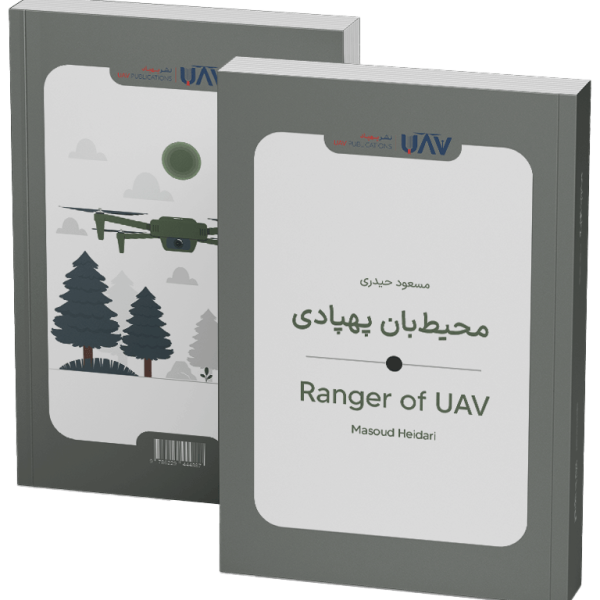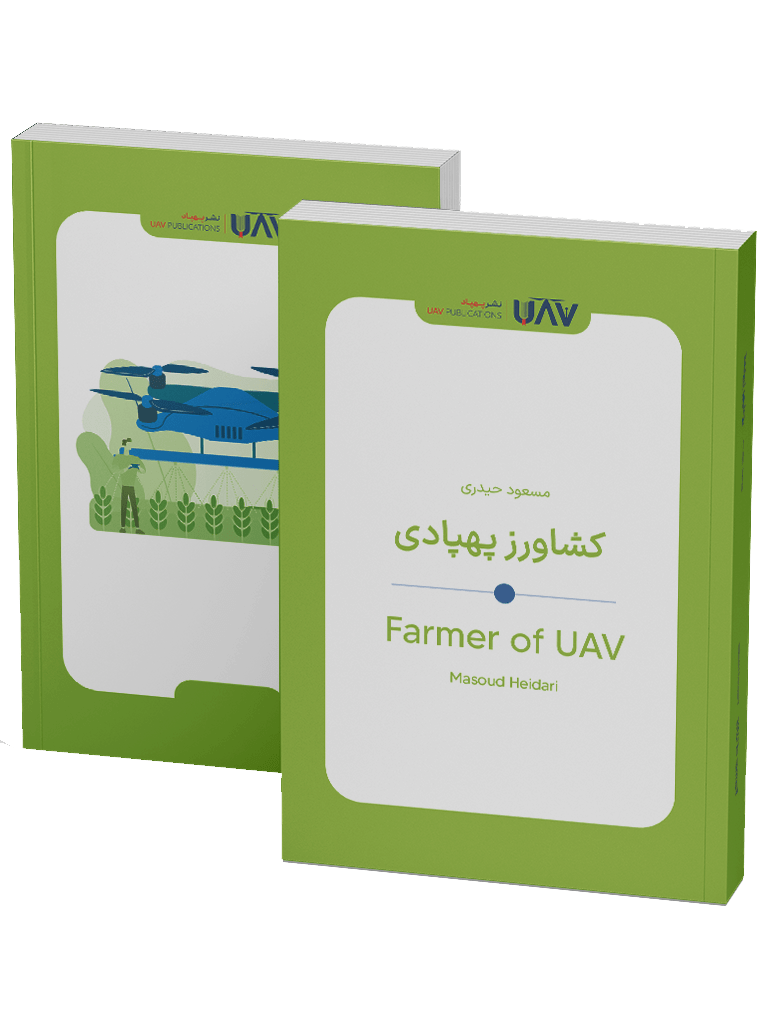Book – Farmer of UAV
The book Drone Agriculture, authored by Masoud Heidari and edited by Hossein Beheshti-Far, stands as the first and most comprehensive Persian-language work dedicated to the use of unmanned aerial vehicles (UAVs) in modern agriculture. Written in clear language and enriched with practical examples, this book serves as a bridge between cutting-edge technology and the soil beneath our feet. From the history of agricultural drones to user training, equipment, advantages, challenges, the state of UAV agriculture in Iran, and its global outlook—this work covers it all.
Whether you are a farmer, a student, a researcher, or simply someone intrigued by forward-looking technologies in the food industry, this book answers your essential questions:
- Which type of UAV is best suited for your farm?
- How can operational costs be reduced?
- What does the future hold for Iranian agriculture with the integration of drones?
Introduction to the Book Drone Agriculture
The book Drone Agriculture, written by Masoud Heidari and edited by Hossein Beheshtifar, is a comprehensive and practical resource on modern agricultural technologies. Published in 2024 by UAV Publications, the book provides a thorough analysis of the transformative impact of drones on modernizing traditional farming. It explores a wide range of topics, from the history of drone integration in agriculture to technical specifications, drone types, real-world applications, international case studies, and the future of this evolving technology.
Additionally, the book offers valuable insights into agricultural software, sensors, peripheral equipment, and the current state of drone agriculture in Iran. Its precise categorization, accessible language, and practical examples make it a reliable reference for students, farmers, researchers, and technology enthusiasts alike. If you are seeking a scientific and precise outlook on the future of agriculture, Drone Agriculture is a must-have on your shelf.
What Is Drone Agriculture?
Drone agriculture refers to the use of unmanned aerial vehicles (UAVs) in various agricultural operations. This cutting-edge technology aims to enhance productivity, reduce operational costs, and optimize the use of natural resources. Drones can be employed for mapping agricultural lands, monitoring plant health, conducting precise irrigation and spraying, and even harvesting crops. Unlike traditional methods, drone agriculture requires significantly less manual labor and minimizes human error.
With the help of multispectral, thermal, or LiDAR sensors, drones deliver highly accurate data on soil and plant conditions, enabling farmers to make well-informed, data-driven decisions. In a country like Iran, which faces severe water shortages and vast stretches of farmland, drone agriculture offers a sustainable and forward-looking solution for effective resource management.
A Brief History of Drone Agriculture
The use of drones in agriculture dates back to the 1980s in Japan, where small radio-controlled helicopters were used to spray rice paddies. However, the 2010s marked a turning point with the advent of more advanced drones equipped with GPS and high-resolution cameras, making them widely accessible for agricultural use.
In 2013, U.S.-based companies, such as PrecisionHawk, began developing specialized drones for crop monitoring. The momentum grew rapidly, and in 2016, the Federal Aviation Administration (FAA) established formal regulations for commercial drone use, significantly supporting the legal framework for drone agriculture. Other countries followed suit, adopting similar regulations and support programs. Today, drone technology is an integral part of precision agriculture systems worldwide.
Leading Countries in Drone Agriculture
Several countries are at the forefront of drone agriculture through substantial investments in research and development, farmer training, and the production of specialized drones. China leads the pack, with DJI revolutionizing the industry by manufacturing thousands of agricultural drones. Japan, with its long-standing experience in drone spraying, remains highly influential in the sector.
In the United States, companies like Sentera and PrecisionHawk offer sophisticated tools for crop analytics. France and Germany use multispectral cameras for monitoring vineyards and optimizing irrigation. Australia has successfully adopted drones for monitoring livestock and managing vast farmlands, particularly in arid regions. These countries exemplify how merging technology with agriculture can yield significant improvements in efficiency and cost reduction.
Educating Farmers in Drone Technology
The success of drone technology in agriculture hinges on farmer education and adoption. As a result, many nations have developed specialized training programs to equip farmers with the skills to use drones effectively. In the U.S., Purdue University offers courses on “Precision Agriculture with UAVs,” covering flight operations, data analysis, and FAA compliance.
In China, the XAG Academy has trained over 50,000 drone operators. Government-backed programs in Japan and Australia also provide free, practical training in collaboration with industry players. These initiatives not only enhance productivity but also reduce pesticide usage, improve crop health, and minimize environmental harm. Given Iran’s urgent need to optimize water resources and implement scientific agricultural management, launching similar training programs could drive major transformation in its agricultural sector.
Types of Agricultural Drones
Agricultural drones vary based on their structure and intended function. The most common categories include:
- Spraying drones are used for the precision application of pesticides and liquid fertilizers.
- Seeding Drones: Disperse seeds evenly over large areas using specialized tanks.
- Pollination drones assist in pollinating crops, especially where natural pollinators, such as bees, are in decline.
- Fogging Drones: Regulate temperature and humidity in controlled environments such as greenhouses.
- Nutrient Sprayers: Apply foliar feeds and nutrient solutions directly to crops for optimal growth.
Each drone type is tailored to specific operational conditions and farm sizes, depending on design, tank capacity, nozzle type, and flight range.
Equipment Used in Agricultural Drones
Agricultural drones are equipped with advanced systems to ensure precise operations with minimal error. These components typically fall into five main categories:
- Spraying Systems: Include replaceable tanks, adjustable nozzles, and pressure control systems.
- Sensors and Cameras: Such as multispectral, thermal, RGB, and LiDAR for crop health monitoring and soil analysis.
- Navigation Systems: Advanced GPS and collision avoidance technologies manage intelligent flight paths.
- Control and Data Software: Enables automated flight, targeted spraying, and data interpretation.
- Specialized Modules: Robotic arms and sampling modules are used in scientific research and greenhouse environments.
These features make drones not just flying devices, but fully functional analytical and operational tools for farm management.
Core Applications of Drones in Agriculture
Drones serve a wide array of purposes across the entire agricultural lifecycle:
- Land Mapping and Topographic Analysis: Generate 3D models to support irrigation design and informed planting strategies.
- Aerial Seeding: Suitable for distributing seeds at the surface level.
- Targeted Spraying: Use multispectral maps to apply pesticides only to infected zones.
- Crop Health Monitoring: Utilize thermal and infrared imaging to detect early signs of disease or stress.
- Irrigation Management: Identify dry zones through vegetation indices.
Additional roles include pest control, livestock monitoring, harvest timing, and crop collection.
Benefits of Drone Use in Agriculture
Drone technology offers a wide range of advantages:
- Time and Labor Savings: Tasks that once required days can now be completed in hours.
- Precision Operations: Minimize input waste and costs associated with spraying and fertilizing.
- Real-Time Monitoring: Enable early detection of pests and diseases.
- Minimal Crop Damage: Avoid physical contact with plants.
- Data-Driven Decision-Making: Provide accurate insights for better farm management.
These benefits lead to higher productivity, lower costs, and enhanced environmental sustainability for modern farmers.
Drone Agriculture in Iran
Although agricultural drone usage in Iran is still in its early stages, signs of rapid development are emerging. In provinces like Golestan, Mazandaran, and Khuzestan, drones are used for spraying rice fields and monitoring pistachio orchards. Several universities and knowledge-based firms are developing indigenous drones, including models for saffron harvesting and agricultural land mapping.
However, challenges such as restrictive regulations, high costs, lack of training, and underdeveloped software infrastructure hinder widespread adoption. Estimates suggest that less than 1% of Iranian farms currently utilize drone technology. Nonetheless, given Iran’s water crisis, labor shortages, and the need for increased efficiency, drones are poised to play a crucial role in the future of Iranian agriculture.
Harvesting Crops with Drones
Drone-based harvesting remains in the experimental phase, yet significant innovations have already been made. Some drones now feature robotic arms capable of delicately picking fruits like apples, saffron, and strawberries. In Iran, drone-assisted saffron harvesting projects have successfully reduced labor needs and increased picking speed.
In countries like Australia and the Netherlands, drones equipped with AI algorithms can identify and selectively pick ripe fruits. Despite current challenges such as limited payload capacity and high energy consumption, integration with autonomous tractors and farm automation systems signals a future where harvesting becomes fully automated and drone-driven.
Recent Advances in Drone Agriculture
Recent years have witnessed remarkable progress in drone agriculture:
- Enhanced Sensor Accuracy: New multispectral and thermal cameras can detect even subtle signs of nutrient deficiency or disease.
- VTOL Drones: Combine quadcopter agility with fixed-wing endurance, ideal for both tight spaces and long-range missions.
- RTK-GPS Systems: Offer sub-centimeter-level positioning accuracy.
- Fully Autonomous Drones: Operate without human intervention and can integrate with ground robots for continuous farm monitoring.
These advancements confirm that drones are evolving from aerial tools into intelligent agricultural partners.
The Future of Drone Agriculture
The future of drone agriculture is dynamic and promising. Integration with AI, IoT, data mining, and machine learning is shaping a brilliant agricultural ecosystem. In this vision, drones will autonomously:
- Monitor crop conditions.
- Detect pests and diseases.
- Perform precision spraying and irrigation.
- Manage livestock.
- Communicate with weather systems for optimal planting and harvesting schedules.
Future drones will be equipped with more durable batteries, advanced robotic arms, and faster data processing systems. In developing countries, efforts are underway to produce affordable, repairable drones for wider accessibility. Precision agriculture is not just a trend—it is the future, and drones will be at its core.
Maintenance and Care of Agricultural Drones
Maintaining agricultural drones is essential for longevity and performance:
- Pre- and Post-Flight Inspections: Regularly check propellers, batteries, connections, and nozzles.
- Professional Battery Management: Avoid overcharging and discharging, and store at ideal temperatures.
- Thorough Cleaning: This is especially important after spraying to prevent corrosion and damage.
- Regular Software Updates: Fix bugs and enable new features.
- User Training and Documentation: Enhance safety and performance by maintaining detailed records and providing operator education.
By following these simple yet vital steps, your drone becomes not just a machine but a reliable and long-term partner in your field operations.
Factors Affecting Agricultural Drone Pricing
Prices for agricultural drones range from a few hundred to several thousand dollars, depending on:
- Tank Capacity and Spraying Precision: Larger tanks and fine nozzles increase cost.
- Sensor and Camera Quality: LiDAR and multispectral sensors are high-cost components.
- Flight Time and Range: Long-endurance drones are more expensive.
- Build Quality and Brand Reputation: Premium brands with solid support cost more.
- Software Features: Automated flight, high-resolution mapping, and remote control are additional features that come at an extra cost.
When purchasing, balance the budget, farm needs, and drone capabilities. More important than the initial cost is the long-term performance, maintenance, and return on investment.
The Role of Drones in Smart Agriculture
The agriculture of tomorrow is not human-centered—it is data-centered, automated, and interconnected. In this digital ecosystem, drones function as the eyes and hands of the farm. They scan fields, collect environmental and biological data, upload it to cloud systems, and receive and execute analytic recommendations.
Paired with AI, IoT, and machine learning, this model enables farm management with laboratory-level precision. Drones will be used not only in crop production but also in livestock management, pathogen detection, fence inspection, disaster monitoring, and even insurance evaluations.
Shortly, every farm will have its drone, and every farmer will command from above—precise, tireless, and always connected.
| Book Author | |
|---|---|
| Book Edition |
First |
| Book Isbn |
978-622-94448-5-6 |
| Book Publish Year | |
| Book Pages |
62 |
| Book Language | |
| Book Publisher |



